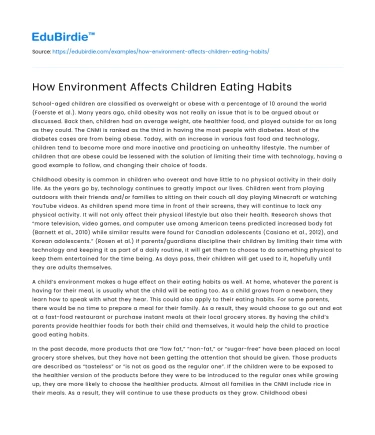School-aged children are classified as overweight or obese with a percentage of 10 around the world (Foerste et al.). Many years ago, child obesity was not really an issue that is to be argued about or discussed. Back then, children had an average weight, ate healthier food, and played outside for as long as they could. The CNMI is ranked as the third in having the most people with diabetes. Most of the diabetes cases are from being obese. Today, with an increase in various fast food and technology, children tend to become more and more inactive and practicing an unhealthy lifestyle. The number of children that are obese could be lessened with the solution of limiting their time with technology, having a good example to follow, and changing their choice of foods.
Childhood obesity is common in children who overeat and have little to no physical activity in their daily life. As the years go by, technology continues to greatly impact our lives. Children went from playing outdoors with their friends and/or families to sitting on their couch all day playing Minecraft or watching YouTube videos. As children spend more time in front of their screens, they will continue to lack any physical activity. It will not only affect their physical lifestyle but also their health. Research shows that “more television, video games, and computer use among American teens predicted increased body fat (Barnett et al., 2010) while similar results were found for Canadian adolescents (Casiano et al., 2012), and Korean adolescents.” (Rosen et al.) If parents/guardians discipline their children by limiting their time with technology and keeping it as part of a daily routine, it will get them to choose to do something physical to keep them entertained for the time being. As days pass, their children will get used to it, hopefully until they are adults themselves.
Save your time!
We can take care of your essay
- Proper editing and formatting
- Free revision, title page, and bibliography
- Flexible prices and money-back guarantee
A child’s environment makes a huge effect on their eating habits as well. At home, whatever the parent is having for their meal, is usually what the child will be eating too. As a child grows from a newborn, they learn how to speak with what they hear. This could also apply to their eating habits. For some parents, there would be no time to prepare a meal for their family. As a result, they would choose to go out and eat at a fast-food restaurant or purchase instant meals at their local grocery stores. By having the child’s parents provide healthier foods for both their child and themselves, it would help the child to practice good eating habits.
In the past decade, more products that are “low fat,” “non-fat,” or “sugar-free” have been placed on local grocery store shelves, but they have not been getting the attention that should be given. Those products are described as “tasteless” or “is not as good as the regular one”. If the children were to be exposed to the healthier version of the products before they were to be introduced to the regular ones while growing up, they are more likely to choose the healthier products. Almost all families in the CNMI include rice in their meals. As a result, they will continue to use these products as they grow. Childhood obesity could be avoided at an early age if the children start to prefer foods that contain less fat over the ones that are full fat, especially if obesity is in their genes.
With all the many improvements that have been made over the past decades, child obesity slowly became an issue. Children all over the world lack the ability to practice living a healthy life. Changing our children's physical and eating lifestyles, would not only improve the child’s health but probably our health as well.






 Stuck on your essay?
Stuck on your essay?

